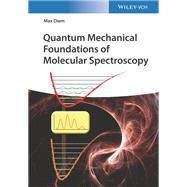A concise textbook bridging quantum theory and spectroscopy!
Designed as a practical text, Quantum Mechanical Foundations of Molecular Spectroscopy covers the quantum mechanical fundamentals of molecular spectroscopy from the view of a professional spectroscopist, rather than a theoretician. Written by a noted expert on the topic, the book puts the emphasis on the relationship between spectroscopy and quantum mechanics, and provides the background information and derivations of the subjects needed to understand spectroscopy including: stationary energy states, transitions between these states, selection rules, and symmetry.
The phenomenal growth of all forms of spectroscopy over the past eight decades has contributed enormously to our understanding of molecular structure and properties. Today spectroscopy covers a broad field including the modern magnetic resonance techniques, non-linear, laser and fiber-based spectroscopy, surface and surface-enhanced spectroscopy, pico- and femtosecond time resolved spectroscopy, and many more. This up-to-date resource discusses several forms of spectroscopy that are used in many fields of science, such as fluorescence, surface spectroscopies, linear and non-linear Raman spectroscopy and spin spectroscopy. This important text:
- Contains the physics and mathematics needed to understand spectroscopy
- Explores spectroscopic methods the are widely used in chemistry, biophysics, biology, and materials science
- Offers a text written by an experienced lecturer and practitioner of spectroscopic methods
- Includes detailed explanations and worked examples
Written for chemistry, biochemistry, material sciences, and physics students, Quantum Mechanical Foundations of Molecular Spectroscopy provides an accessible text for understanding molecular spectroscopy.









